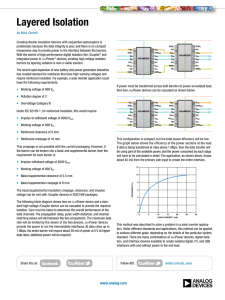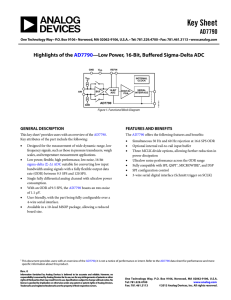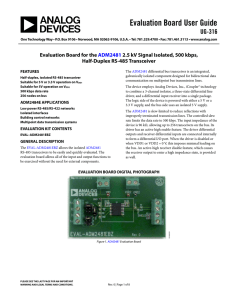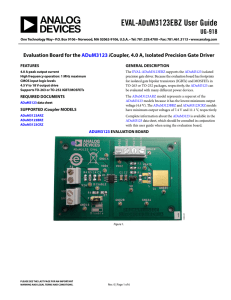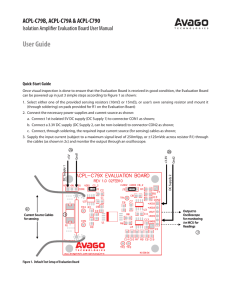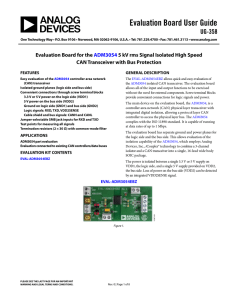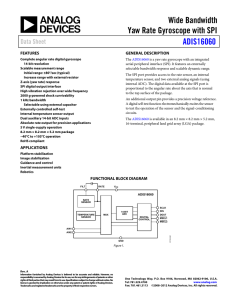Functional SPI Isolation
advertisement
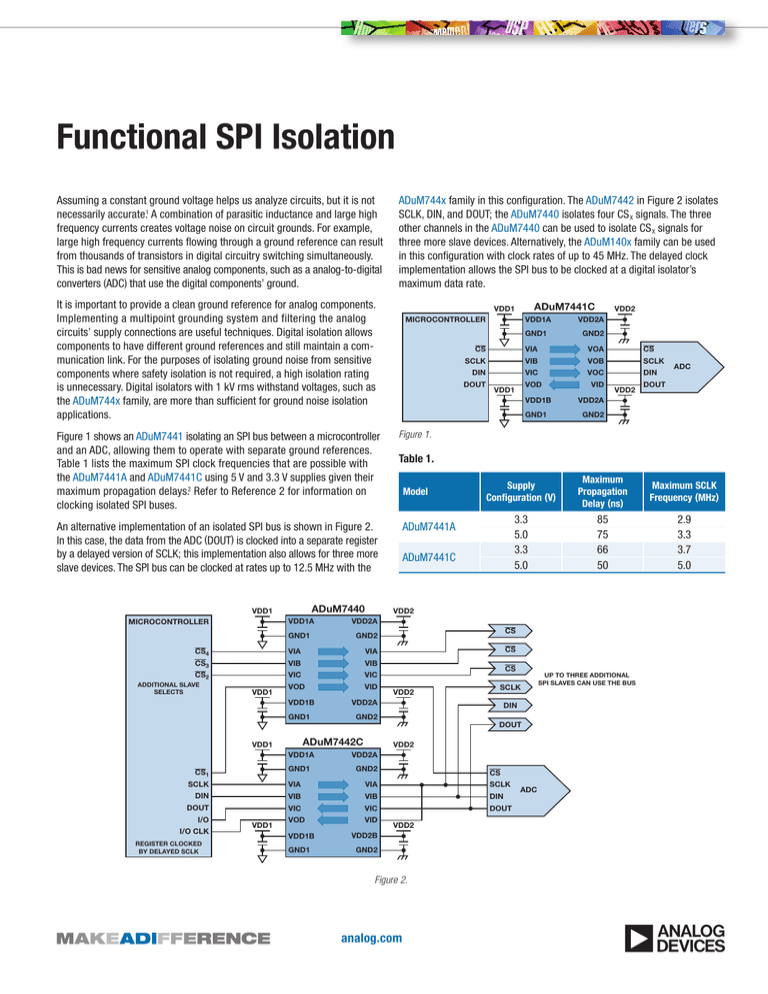
Functional SPI Isolation Assuming a constant ground voltage helps us analyze circuits, but it is not necessarily accurate.1 A combination of parasitic inductance and large high frequency currents creates voltage noise on circuit grounds. For example, large high frequency currents flowing through a ground reference can result from thousands of transistors in digital circuitry switching simultaneously. This is bad news for sensitive analog components, such as a analog-to-digital converters (ADC) that use the digital components’ ground. ADuM744x family in this configuration. The ADuM7442 in Figure 2 isolates SCLK, DIN, and DOUT; the ADuM7440 isolates four CS X signals. The three other channels in the ADuM7440 can be used to isolate CS X signals for three more slave devices. Alternatively, the ADuM140x family can be used in this configuration with clock rates of up to 45 MHz. The delayed clock implementation allows the SPI bus to be clocked at a digital isolator’s maximum data rate. It is important to provide a clean ground reference for analog components. Implementing a multipoint grounding system and filtering the analog circuits’ supply connections are useful techniques. Digital isolation allows components to have different ground references and still maintain a communication link. For the purposes of isolating ground noise from sensitive components where safety isolation is not required, a high isolation rating is unnecessary. Digital isolators with 1 kV rms withstand voltages, such as the ADuM744x family, are more than sufficient for ground noise isolation applications. Figure 1 shows an ADuM7441 isolating an SPI bus between a microcontroller and an ADC, allowing them to operate with separate ground references. Table 1 lists the maximum SPI clock frequencies that are possible with the ADuM7441A and ADuM7441C using 5 V and 3.3 V supplies given their maximum propagation delays.2 Refer to Reference 2 for information on clocking isolated SPI buses. ADuM7440 VDD1 VDD2A GND1 GND2 VIA VIA CS3 VIB VIB CS2 VIC VIC VOD VID VDD1 VDD1B VDD2A GND1 GND2 ADuM7442C VDD1 CS1 VOA CS VIB VOB SCLK DIN VIC VOC DIN VDD2A GND1 GND2 VDD2 VDD2A GND1 GND2 Model Supply Configuration (V) Maximum Propagation Delay (ns) Maximum SCLK Frequency (MHz) 3.3 5.0 3.3 5.0 85 75 66 50 2.9 3.3 3.7 5.0 ADuM7441A ADuM7441C CS CS CS VDD2 SCLK DIN DOUT CS SCLK VIB DIN DOUT VIC VIC DOUT VID VDD2B GND1 GND2 DOUT Table 1. VIB VDD1B ADC Figure 1. DIN REGISTER CLOCKED BY DELAYED SCLK VID VDD1B VDD2 VDD1A VOD VOD VDD1 VIA VDD1 GND2 SCLK VIA I/O GND1 VIA SCLK I/O CLK VDD2A VDD2 VDD1A CS4 ADDITIONAL SLAVE SELECTS VDD2 VDD1A CS DOUT An alternative implementation of an isolated SPI bus is shown in Figure 2. In this case, the data from the ADC (DOUT) is clocked into a separate register by a delayed version of SCLK; this implementation also allows for three more slave devices. The SPI bus can be clocked at rates up to 12.5 MHz with the MICROCONTROLLER ADuM7441C VDD1 MICROCONTROLLER VDD2 Figure 2. analog.com ADC UP TO THREE ADDITIONAL SPI SLAVES CAN USE THE BUS References 1 Ott, H.W. Noise Reduction Techniques in Electronic Systems. New York, NY: John Wiley & Sons, 1988. pp. 73–115. 2 Cantrell, M. “Clocking Options for SPI.” http://www.analog.com/static/imported-files/newsletters/digital_isolation/iCoupler_0308.html Analog Devices, Inc. Worldwide Headquarters Analog Devices, Inc. One Technology Way P.O. Box 9106 Norwood, MA 02062-9106 U.S.A. Tel: 781.329.4700 (800.262.5643, U.S.A. only) Fax: 781.461.3113 Analog Devices, Inc. Europe Headquarters Analog Devices, Inc. Wilhelm-Wagenfeld-Str. 6 80807 Munich Germany Tel: 49.89.76903.0 Fax: 49.89.76903.157 Analog Devices, Inc. Japan Headquarters Analog Devices, KK New Pier Takeshiba South Tower Building 1-16-1 Kaigan, Minato-ku, Tokyo, 105-6891 Japan Tel: 813.5402.8200 Fax: 813.5402.1064 Share this on: ©2011 Analog Devices, Inc. All rights reserved. Trademarks and registered trademarks are the property of their respective owners. T10184-0-9/11 Follow ADI: analog.com twitter.com/adi_news Analog Devices, Inc. Southeast Asia Headquarters Analog Devices 22/F One Corporate Avenue 222 Hu Bin Road Shanghai, 200021 China Tel: 86.21.2320.8000 Fax: 86.21.2320.8222
